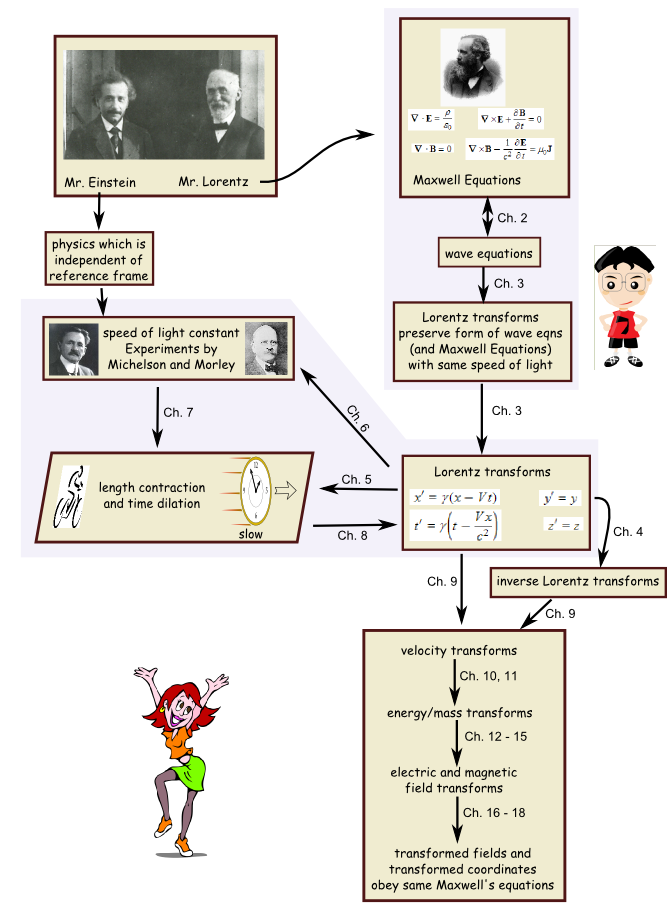| all topics by author | introduction to relativity | contents of mathematics of relativity | next: Electromagnetic wave equation from Maxwell's equations |
|---|---|---|---|
1. Introduction
Lorentz's logic:2. Electromagnetic wave equation from Maxwell's equations
3. Invariance of the wave equation
4. Inverting Lorentz transforms
5. Length contraction and time dilation from Lorentz transforms
6. A constant speed of light from Lorentz transforms
Einstein's logic:
7. Length contraction and time dilation from a constant speed of light flash animations
8. Lorentz transforms from length contraction and time dilation
Equations shared by both Einstein and Lorentz:
11. Relativistic kinetic energy
12. Electromagnetic fields-intro and contents
13. Transforming charge and current densities
14. Four-vectors
15. Electric and magnetic field transforms
Rechecking the invariance of Maxwell's equations:
16. Transforming Maxwell's equations-intro and 1st ME
17. Transforming Maxwell's equations 2, 3 and 4
18. Separating the transformed Maxwell equations
19. References
1. Mathematical derivations of special relativity - introduction
This section involves a number of mathematical derivations. They are meant to show the underpinnings of relativity, both from Einstein's point of view and Lorentz's point of view. There is an outline of the various chapters at the right and a flow chart of the logical progression of the chapters at the bottom of this posting. If you are interested in a non-mathematical treatment of relativity which stresses the history, the phenomena, and philosophy, see my earlier introduction to relativity.
Einstein's view was that all of relativity flows from the truth that physics should look the same in all inertial reference frames (reference frames traveling at constant velocity). This means the speed of light is the same, and all basic equations of physics are the same in all inertial reference frames.
Lorentz's point of view was that the above consistency was simply an illusion that was made possible by an oddity in Maxwell's equations. His view was that the speed of light and the equations of physics really differ in different inertial reference frames. However, people and their instruments in these frames are affected in such a way as to make the speed of light and the equations of physics seem the same. Furthermore, he felt that there probably is a true "at rest" (or universal) reference frame, but as yet we do not know how to ascertain which reference frame that is. This would be perhaps like the early chemists (Boyle, Lavoisier, etc.) who didn't have a chance of directly verifying the existence of atoms or molecules, but still correctly used atoms and molecules as central entities in their theories.
As was explained in the previous postings, the two views are mathematically identical and barring any future discovery, we may never know which is really "correct". In any case, in this section we present the mathematics behind relativity.
For the most part, the mathematics in the following postings follow the standard relativity derivations, i.e. they follow Einstein's logic: starting with a constant speed of light and going on to derive transformations between reference frames for all sorts of physical quantities.
In addition to the standard logical progression, we include a few derivations, at the very beginning, supporting Lorentz's views. These derive the electromagnetic wave equation from Maxwell's equations to illustrate the lack of reference frame in the wave equation. We go on to show that the electromagnetic wave equation is not invariant under the old Galilean velocity transforms, but it is invariant under Lorentz transformations. We also discuss the implications of this from Lorentz's point of view.
To some extent, the chapters can be read individually to suit one's interest. For example, people interested primarily in the conventional Einsteinian logic might be mostly interested in reading Chapter 7 and a few chapters thereafter.
| Flowchart for the math of relativity |
|---|

|
| Fig. 1.1. This illustration shows the logical flow of this math section: which chapter shows which relationship. |
| all topics by author | introduction to relativity | contents of mathematics of relativity | next: Electromagnetic wave equation from Maxwell's equations |
|---|---|---|---|